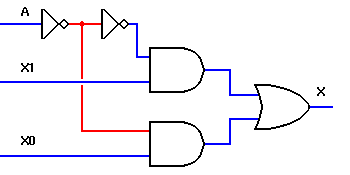
The multiplexer circuit is typically used to combine two or more digital signals onto a single line, by placing them there at different times. Technically, this is known as time-division multiplexing.
Input A is the addressing input, which controls which of the two data inputs, X0 or X1, will be transmitted to the output. If the A input switches back and forth at a frequency more than double the frequency of either digital signal, both signals will be accurately reproduced, and can be separated again by a demultiplexer circuit synchronized to the multiplexer.
This is not as difficult as it may seem at first glance; the telephone network combines multiple audio signals onto a single pair of wires using exactly this technique, and is readily able to separate many telephone conversations so that everyone's voice goes only to the intended recipient. With the growth of the Internet and the World Wide Web, most people have heard about T1 telephone lines. A T1 line can transmit up to 24 individual telephone conversations by multiplexing them in this manner.